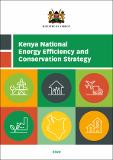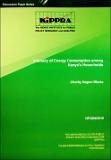| dc.description.abstract | The country’s development blueprint Kenya Vision 2030 identifies energy as a key driver of the economy. However, the sector remains a high contributor of carbon dioxide emissions. This study examines the effect of using renewable energy sources to reduce carbon dioxide emissions from the energy sector from 1971 to 2013. Elasticities of other factors such as energy efficiency, population and GDP which reduce carbon dioxide emissions were also estimated. Using data from the Kenya National Bureau of Statistics and the World Bank, this study uses the Instrumental Variable (IV) approach to estimate the elasticities. Gross Domestic Product and Energy Efficiency were found to be endogenous. After correcting for endogeneity, the results revealed that renewable energy usage and energy efficiency were significant factors for reducing carbon dioxide emissions from the energy sector both in the short and long run. The result also showed that GDP and population increase carbon dioxide emissions. In terms of policy, the study recommends measures towards increasing renewable energy production, as well as adopting energy efficient measures. Increased production from renewable energy sources can be achieved by reviewing the Feed-in-Tariffs to encourage private investors in the renewable energy sector. The government should increase investment in renewable energy sector particularly for wind, geothermal, solar projects and planting of energy crops such as miscanthus and jatropha. Energy efficiency can be achieved by use of upgraded technology in buildings, appliances, and industry as well as end-user applications, efficient lighting and heating, replacing old technologies with new ones in manufacturing, reusing waste heat and adoption of clean technology in its exploitation. | en |




